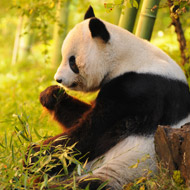Low metabolism allows pandas to survive on bamboo

"Pandas save a lot of energy by being frugal with the energy they spend on physical activity."
Giant pandas have an incredibly low metabolic rate which allows them to survive on bamboo, according to new research.
The panda began eating bamboo exclusively around two million years ago, but because its gut is designed for digesting meat, this causes the bear huge problems. As a result, pandas have to consume up to 50lbs of bamboo a day to survive.
How pandas survive on such a poor diet has been a mystery until now, but it has been widely speculated that an essential part of their ability to do so is having a low energy demand.
In the study, published in the journal Science, researchers from the Chinese Academy of Sciences, Beijing Zoo and the University of Aberdeen measured the metabolic rates of pandas living both in the wild and in captivity.
They found that the metabolism of a panda is exceptionally low - a 90kg panda expends less than 50 per cent of the energy of a human weighing 90kg.
The research also found that there are several factors which contribute to the panda's low metabolism. Co-first author Professor John Speakman explains:
"Pandas save a lot of energy by being frugal with the energy they spend on physical activity. Using GPS loggers attached to pandas we discovered that they rest for more than half of the day and on average, only travelled at 20 meters an hour.
"However, it is not only their low activity that contributes to their low metabolism; the metabolic rate of an active panda is still lower than a completely stationary human. We found that their low metabolism is correlated with very low levels of their thyroid hormones, which was linked to a genetic mutation in the thyroid hormone syntheses pathway that is unique to the panda."
The panda's low metabolic rate means that they struggle to keep warm. Using a thermal camera, the team found that while the panda's thick fur traps what body heat they have inside, their surface temperature is much lower than other black and white animals such as dalmatians and zebras.
"It has been a real pleasure to be involved in the international collaboration which has revealed some amazing insights into how the panda manages to survive on its bamboo diet," said Professor Speakman.
"The combination of behavioural and physiological responses that enable this low metabolic rate is fascinating."
Co-author Professor Fuwen Wei added: "It is my long-term dream to accomplish this fascinating study to understand how low the giant panda metabolism would be, and why the giant panda can survive on their specialised and low quality bamboo diet. Finally we have done it!"



 The BSAVA has opened submissions for the BSAVA Clinical Research Abstracts 2026.
The BSAVA has opened submissions for the BSAVA Clinical Research Abstracts 2026.